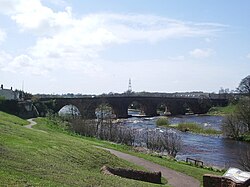Longtown, Cumberland: Difference between revisions
m clean up, typos fixed: , → , |
mNo edit summary |
||
| Line 22: | Line 22: | ||
Longtown has one primary school with around 190 pupils, most secondary school pupils travel to William Howard School in [[Brampton, Cumberland|Brampton]], though Longtown had its own secondary school, Lochinvar School, until 2008. | Longtown has one primary school with around 190 pupils, most secondary school pupils travel to William Howard School in [[Brampton, Cumberland|Brampton]], though Longtown had its own secondary school, Lochinvar School, until 2008. | ||
The first animal to be found to be infected with foot-and-mouth disease in the 2001 crisis | The first animal to be found to be infected with foot-and-mouth disease in the 2001 crisis had been purchased at Longtown market. While at the market it spread the infection to other animals. The size of the Longtown sheep market meant that the disease had spread right across the country in a very short time. Longtown became the centre for control of the disease from Galloway to Lancashire. | ||
In April 2014 the council rejected a planning application for a two million gallon slurry lagoon at Scaurbank Wood, to the north east of Longtown. The planned slurry lagoon was said to be the most objected to plan in the City Council's history, with more than 1,400 letters or e mails of objection.<ref>'Tide against the Slurry lagoon plan too strong to be ignored' The Cumberland News 18 April 2014</ref> | In April 2014 the council rejected a planning application for a two million gallon slurry lagoon at Scaurbank Wood, to the north east of Longtown. The planned slurry lagoon was said to be the most objected to plan in the City Council's history, with more than 1,400 letters or e mails of objection.<ref>'Tide against the Slurry lagoon plan too strong to be ignored' The Cumberland News 18 April 2014</ref> | ||
Latest revision as of 14:59, 20 September 2017
| Longtown | |
| Cumberland | |
|---|---|
 Longtown, bridge over the River Esk | |
| Location | |
| Grid reference: | NY380686 |
| Location: | 55°-0’30"N, 2°58’7"W |
| Data | |
| Population: | 3,000 |
| Post town: | CARLISLE |
| Postcode: | CA6 |
| Dialling code: | 01228 |
| Local Government | |
| Council: | Cumberland |
| Parliamentary constituency: |
Penrith and The Border |
Longtown is a village in northern Cumberland, with a population of around 3,000. It is in the parish of Arthuret and on the River Esk, close by the boundary with Dumfriesshire.
At Longtown is held the largest sheep market in England
In 1542 the Battle of Solway Moss was fought close to the village.
Longtown has one primary school with around 190 pupils, most secondary school pupils travel to William Howard School in Brampton, though Longtown had its own secondary school, Lochinvar School, until 2008.
The first animal to be found to be infected with foot-and-mouth disease in the 2001 crisis had been purchased at Longtown market. While at the market it spread the infection to other animals. The size of the Longtown sheep market meant that the disease had spread right across the country in a very short time. Longtown became the centre for control of the disease from Galloway to Lancashire.
In April 2014 the council rejected a planning application for a two million gallon slurry lagoon at Scaurbank Wood, to the north east of Longtown. The planned slurry lagoon was said to be the most objected to plan in the City Council's history, with more than 1,400 letters or e mails of objection.[1]
Peel Tower
A little over two miles to the north, on the west bank of the River Esk, stands Kirkandrews Tower, an isolated and well-preserved 16th century peel tower.[2]
Coal Mining
Lochinvar coalfield was discovered in the 1950s by the National Coal Board and was subject to drilling but never mined. Recently an Australian firm (New Age Exploration) has been exploring the coalfield for coking coal to produce steel. The company is exploring as far north as Evertown near Canonbie, and as far south as Longtown.[3]
DMC Longtown
During the 1930s, there was a recognition of a need to provide secure storage for munitions across the United Kingdom. The proposal was to create three Central Ammunition Depots (CAD): one in the south (Monkton Farleigh, Wiltshire); one in the Midlands (Nesscliffe, Shropshire); and one in the north.
While the other two sites were sat above easily hewn limestone, Longtown is located above granite, which meant that it took longer to create and only came into operations late in Second World War. The site was chosen as it used to be part of HM Factory, Gretna, that stretched to Eastriggs in Dumfriesshire, one of the biggest makers of explosives during World War I. The township of Gretna was established to house the workers of this establishment.
Today, DMC (Defence Munitions Centre) Longtown is the only one of the three CADs to remain in operation today, one of the biggest defence munitions sites in Western Europe. Currently Longtown and Eastriggs are two separate sites jointly managed. In November 2013 the MOD announced that the operational capacity of MOD Longtown would be reduced and a substantial area of the site would be given over to commercial use.
Outside links
References
- ↑ 'Tide against the Slurry lagoon plan too strong to be ignored' The Cumberland News 18 April 2014
- ↑ National Monuments Record: No. 10859 – Kirkandrews Tower
- ↑ The Cumberland News 7th March 2014 'Coal-mining scheme set to expand'